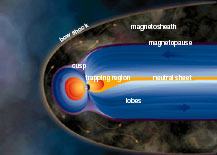Artist conception of the CAPER trajectory
Click on image for full size
Image courtesy of NASA/Marshall
Scientists Successfully Launch CAPER
News story originally written on January 23, 1999
After waiting weeks for the right solar and atmospheric conditions,
scientists were finally able to launch the Cleft Acceleration Plasma
Experimental Rocket (CAPER) from Andoya Rocket Range in Norway.
CAPER will help determine what causes low energy particles to
leave the Earth's atmosphere. The current
theory is that electrical instabilities in the
ionosphere give ions the
energy that is needed to escape.
"We're studying a region that is believed to provide the majority of the
mass that makes up the
magnetosphere," said
Victoria Coffey, a scientist at NASA's Marshall Space Flight Center.
You might also be interested in:

The Earth has a magnetic field with north and south poles. The magnetic field of the Earth is enclosed in a region surrounding the Earth called the magnetosphere. As the Earth rotates, its hot core generates
...more
It was another exciting and frustrating year for the space science program. It seemed that every step forward led to one backwards. Either way, NASA led the way to a great century of discovery. Unfortunately,
...more
The Space Shuttle Discovery lifted off from Kennedy Space Center at 2:19 p.m. EST, October 29th. The sky was clear and the weather was great as Discovery took 8 1/2 minutes to reach orbit for the Unitied
...more
A moon was discovered orbiting the asteroid, Eugenia. This is only the second time in history that a satellite has been seen circling an asteroid. A special mirror allowed scientists to find the moon
...more
Will Russia ever put the service module for the International Space Station in space? NASA officials are demanding an answer from the Russian government. The necessary service module is currently waiting
...more
During a period of about two days in early May, 1998, the ACE spacecraft was immersed in plasma associated with a coronal mass ejection (CME). The SWICS instrument on ACE, which determines unambiguously
...more
J.S. Maini of the Canadian Forest Service has referred to forests as the "heart and lungs of the world." Forests reduce soil erosion, maintain water quality, contribute to atmospheric humidity and cloud
...more









